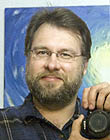|
|
 
|
|
Author
|
Topic: Amega M-3 Fullcoat recorder
|
|
|
|
|
|
|
|
|
|
|
|
|
|
|
Sean Weitzel
Jedi Master Film Handler

Posts: 619
From: Vacaville, CA (1790 miles west of Rockwall)
Registered: Dec 1999
|
 posted 01-18-2010 10:18 PM
posted 01-18-2010 10:18 PM




Magnetic striping is a very rare process and only a few are doing it anymore. Most of it is geared towards super8mm films. I believe, but am not certain that Paul Yost in San Carlos, CA does 16mm striping at $0.35 a foot. You should definitely contact him before sending in your film.
http://lavender.fortunecity.com/lavender/569/poststripeservices.html
If that service is no longer available, you will likely have to ship your film to Germany. Andec Film or Wittner may do 16mm striping.
You are correct that having an optical track made will be very expensive. If you are starting with a positive, you will likely pay in the neighborhood of $0.40 a foot for the track neg, and whatever the lab charges for an internegative, and an answer print. http://www.cinemalab.com/ was one lab I was able to find that offers track negatives and publishes their prices online. I know http://www.alphacine.com/ was offering all of these services, but I was unable to find prices for track negatives listed in their rate card. It's possible http://www.colorlab.com/ may offer these services as well, but I was not able to find and concrete reference.
It's a shame how the world changed. Years ago, labs used to offer a service called "electroprinting" that took away the need to have an optical track made. Basically, you conformed a positive, and sent that with a fullcoat magnetic track to the lab and they made a print on reversal film and printed in the soundtrack at the same time directly onto the print. W.A. Palmer films in Belmont, CA were a notable lab offering this service.
Good luck with your project!
| IP: Logged
|
|
|
|
|
|
All times are Central (GMT -6:00)
|
|
Powered by Infopop Corporation
UBB.classicTM
6.3.1.2
The Film-Tech Forums are designed for various members related to the cinema industry to express their opinions, viewpoints and testimonials on various products, services and events based upon speculation, personal knowledge and factual information through use, therefore all views represented here allow no liability upon the publishers of this web site and the owners of said views assume no liability for any ill will resulting from these postings. The posts made here are for educational as well as entertainment purposes and as such anyone viewing this portion of the website must accept these views as statements of the author of that opinion
and agrees to release the authors from any and all liability.
|

 Home
Home
 Products
Products
 Store
Store
 Forum
Forum
 Warehouse
Warehouse
 Contact Us
Contact Us




 Printer-friendly view of this topic
Printer-friendly view of this topic








![[Embarrassed]](redface.gif) (.
(.


